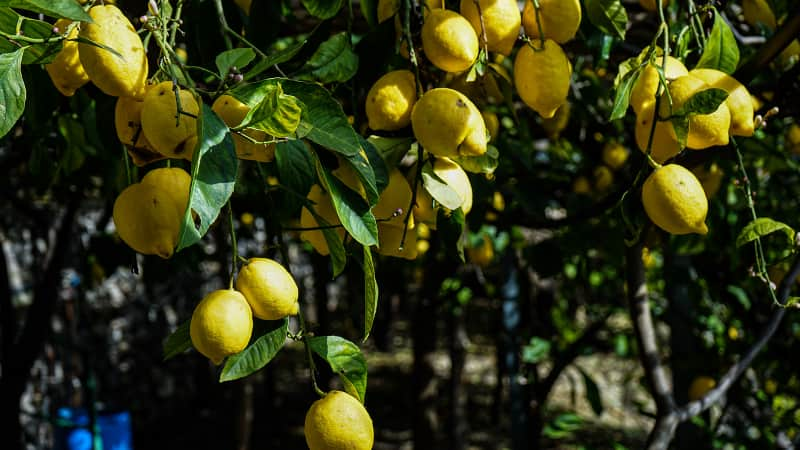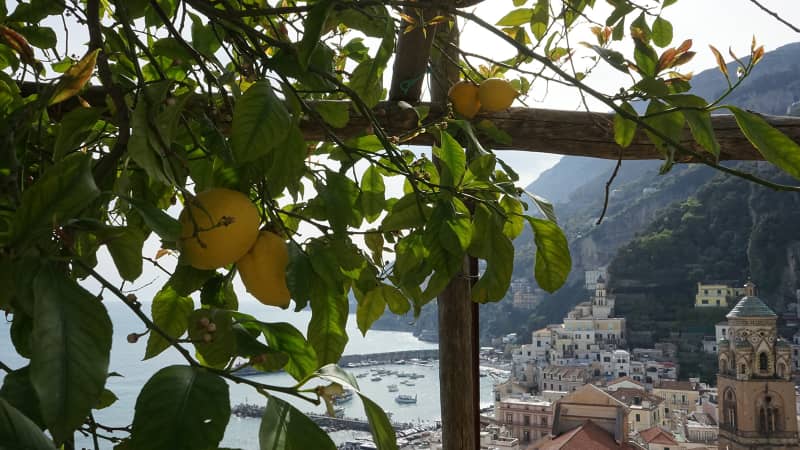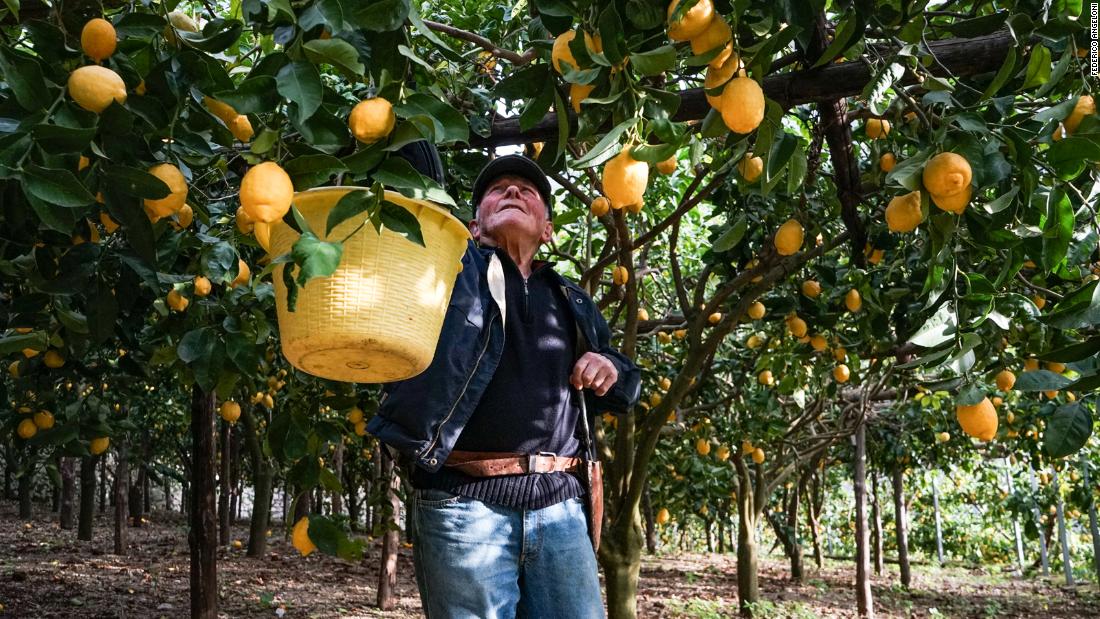Amalfi, Italy (CNN) — Above the green hills of the Amalfi Coast in southern Italy, an agile farmer leaps across terraced lemon groves overlooking the Mediterranean Sea.
Balancing between one wooden pole and another, the not-so-young acrobat defies gravity, bending to pick lemons and transport them in crates weighing more than 25 kilograms (55 pounds) between vertical gardens more than 400 meters (1,312 feet) above the ground.
A strong aroma of rosemary surrounds him, blended with jasmine, sage, and, of course, the unique bittersweet scent of citrus. The sound of waves below masks the hum of car traffic and noise from tourists in the main square of the UNESCO-protected town of Amalfi.
“Not blood, but lemon juice runs through my veins,” says 87-year-old farmer Gigino Aceto, whose family has been growing lemons here since the 1800s.
From dawn to dusk, Aceto’s life revolves all around lemons. He sleeps in his lemon groves and feeds on lemon food. He was even conceived among these plants.
“In my parents’ old days, the lack of space and intimacy meant that love was made outdoors, underneath the citrus trees,” he says with a smile.
Gigantic fruit

Low-hanging fruit: The Amalfi lemons are known for their large size.
Federico Angeloni
The lemons are the beating heart of the area’s complex, biodiverse ecosystem, which has remained unchanged for centuries. But Aceto is among the last guardians of this vulnerable tradition now threatened by industrialization, changes in society and climate change.
“In Amalfi alone, lemon terraces have decreased from 72 hectares to 48 between 1954 and 2015, while wild forests and urbanization advanced considerably,” says Giorgia De Pasquale, an architect and researcher at Roma Tre University, who is looking for ways to preserve family lemon-growing businesses.
De Pasquale has been working to get “Globally Important Agricultural Heritage System” status for Amalfi’s lemon groves — a designation under a United Nations Food and Agriculture Organization program.
“The process taking place in Amalfi is identical throughout the coast,” she says.
A cure for all
With its light-yellow color, intense fragrance, juicy texture and sweet skin — it can be eaten sliced like an apple — the Sfusato has become a staple ingredient in the area’s traditional cuisine.
It’s used in pasta dishes, sauces for salads and grilled fish, desserts — not to mention Italy’s famous Limoncello liqueur. And because of its properties — it is rich in vitamins C, B, E, potassium and magnesium — the inhabitants of the coast have found myriad uses, from cleaning clothes to natural medicine.
“The first thing we do as we wake up with a headache is to put a little lemon peel in our morning coffee,” Aceto explains. “When we cut ourselves, we run to get a lemon to sanitize. If we feel sick, there’s nothing that lemon spaghetti cannot fix.”
But it’s not only nutritional and pharmacological properties that made the Sfusati so fundamental to the area. The traditional agricultural system — a remarkable 15th-century example of man and nature working in harmony — has proven resilient to climate change instability.
Sculpting the wild cliffs overlooking the sea, the orderly architecture of the lemon groves curb some of the area’s worst problems, including landslides caused by rain and wildfires.
“Farmers provide a systemic service to the whole area, protecting the coastline from landslides and other environmental disasters,” says De Pasquale. Without this agricultural activity, she adds, the landscape of Amalfi and the entire coastline would vanish, deteriorating year after year.
‘A disaster’

Lemon groves fill the steep slopes.
Federico Angeloni
Vertically arranged in layers, the lemon groves are separated by three- to seven-meter walls made of Macere — a local limestone resistant to soil pressure and impervious to rain. Even today, the grove can only be reached on foot or by mules.
The terracing system exploits the force of gravity to direct rainwater to irrigate the plants.
“Everything works perfectly in synergy with the land,” says Aceto’s 57-year-old son, Salvatore. Nevertheless, he says, the farmers are fighting a constant battle against man-made problems, not least scorching temperatures blamed on climate change.
“With the frequent fires over summer, it’s a disaster,” he says.
“Maintaining the land has to be a collective work. The terraces are linked to each other. But today they have been either abandoned or turned into holiday homes and illegal constructions.”
Low profitability and high costs of the traditional agriculture system have pushed more and more Amalfitans off the land, causing walls to crumble. Tourism, increasing to problematic levels in parts of Amalfi, has given them another, perhaps easier, source of income.
“Work is hard here, not like in the valley, but nobody wants to work hard anymore,” says Salvatore Aceto, his dialect solidly Neapolitan. “At the same time, they use cheaper methods, like cement [or] lime, which damage the landscape, preventing drainage and causing landslides.”
A dying art
In Minori, a town along Italy’s Amalfi Coast, Stanley Tucci samples lemons he calls the best in the world.
There’s a risk, he says, that when his generation stops cultivating the land, the knowledge accumulated over the centuries by local communities could vanish altogether.
“Most tourists who come to Amalfi are unaware of this system just across the main road,” explains De Pasquale, leaving farmers cut off from the tourism dollars pouring into the region.
They lead groups of up to five people, spending hours among terraces built over a thousand years ago, teaching them culinary skills like cooking a dish of lemon Scialatielli or processing local honey.
“It is convenient to have a certain image of the Amalfi coast, but we don’t bow to tourists and distort our business,” said Salvatore. “We are farmers, and this is what we show.”
“At 5.30 a.m., my clothes are soiled, and my knees are exhausted. It’s a job that destroys you. These are two faces of Amalfi — the one you want tourists to see,” he says, pointing down the slopes to the town below. “And the real one, the farmers’ real life.”
“Down below has become something else.”
